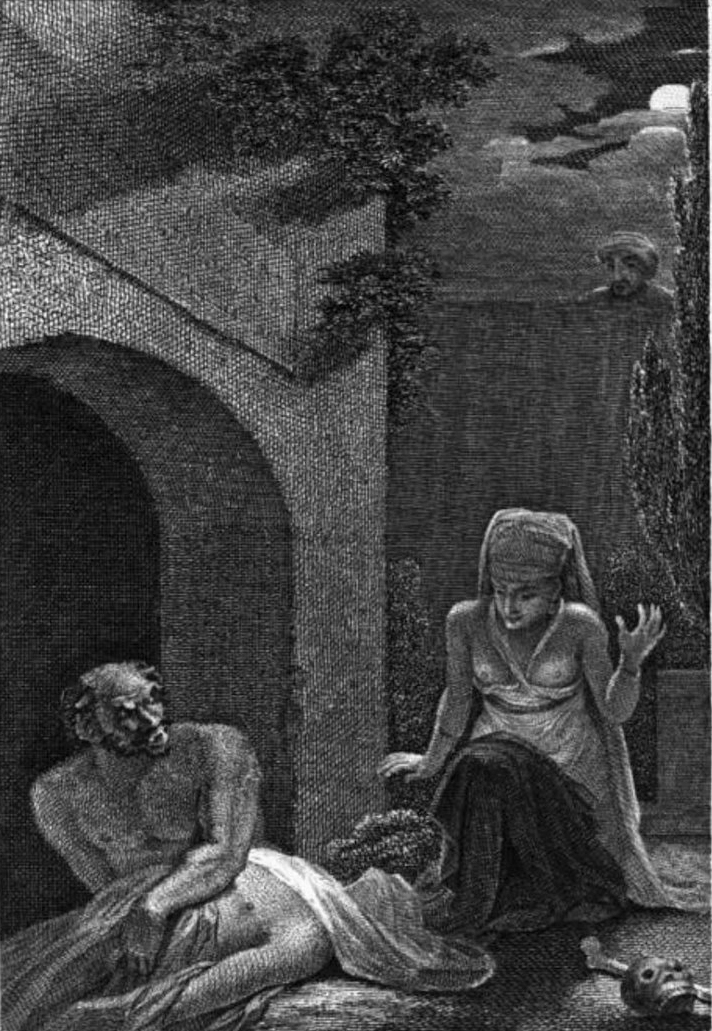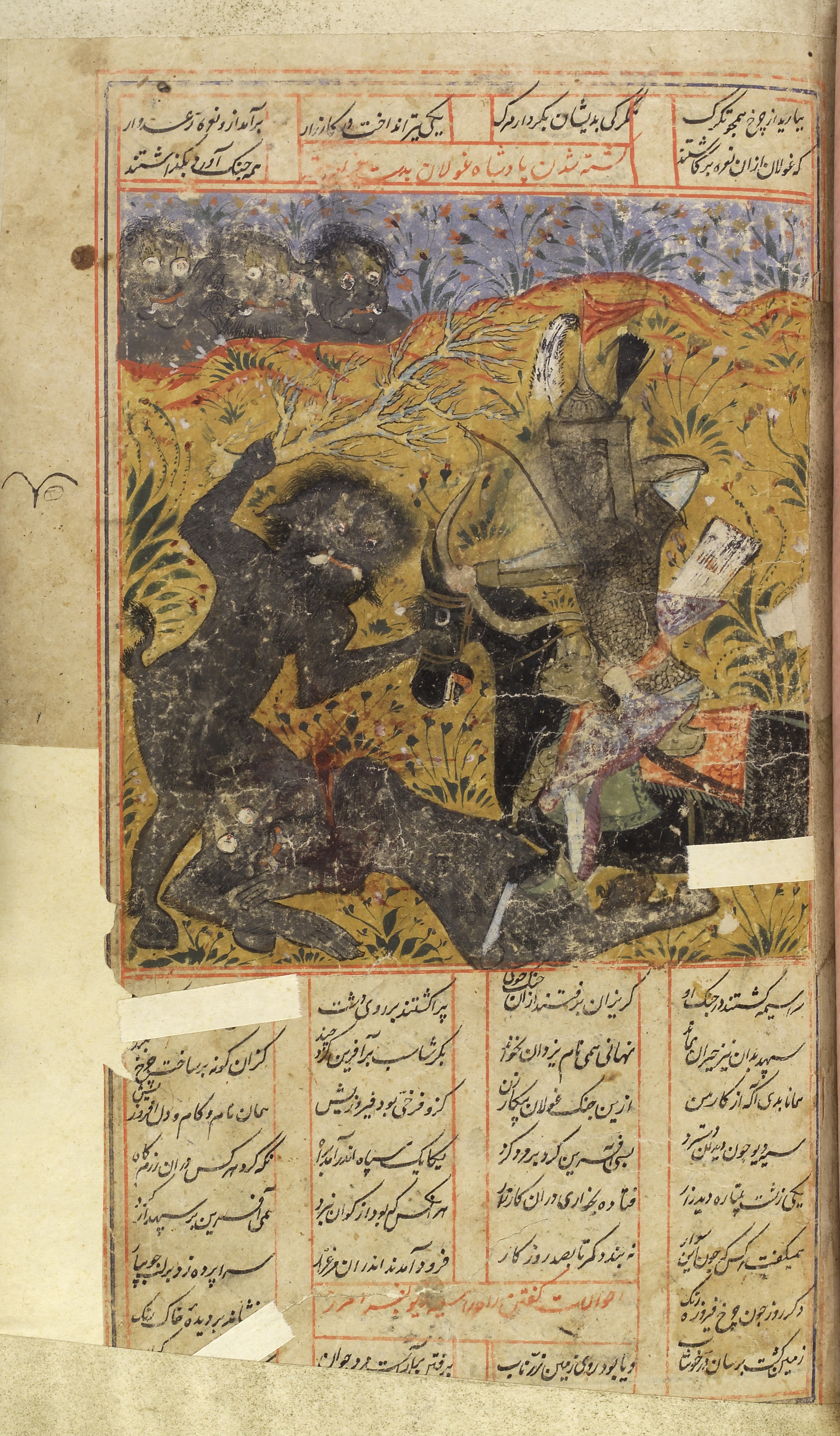Ghoul on:
[Wikipedia]
[Google]
[Amazon]
 A ghoul ( ar, غول, ') is a
A ghoul ( ar, غول, ') is a
 In Arabic folklore, the ''ghul'' is said to dwell in
In Arabic folklore, the ''ghul'' is said to dwell in
 A ghoul ( ar, غول, ') is a
A ghoul ( ar, غول, ') is a demon
A demon is a malevolent supernatural entity. Historically, belief in demons, or stories about demons, occurs in religion, occultism, literature, fiction, mythology, and folklore; as well as in Media (communication), media such as comics, video ...
-like being or monstrous humanoid. The concept originated in pre-Islamic Arabian religion, associated with graveyards and the consumption of human flesh. Modern fiction often uses the term to label a certain kind of undead
The undead are beings in mythology, legend, or fiction that are deceased but behave as if alive. Most commonly the term refers to corporeal forms of formerly-alive humans, such as mummies, vampires, and zombies, who have been reanimated b ...
monster.
By extension, the word ghoul is also used in a derogatory sense to refer to a person who delights in the macabre or whose occupation directly involves death, such as a gravedigger
A gravedigger is a cemetery worker who is responsible for digging a grave prior to a funeral service.
Description
If the grave is in a cemetery on the property of a church or other religious organization (part of, or called, a churchyard), g ...
or graverobber.
Etymology
Ghoul is from theArabic
Arabic (, ' ; , ' or ) is a Semitic language spoken primarily across the Arab world.Semitic languages: an international handbook / edited by Stefan Weninger; in collaboration with Geoffrey Khan, Michael P. Streck, Janet C. E.Watson; Walter ...
''ghūl'', from ''ghāla'', "to seize". In Arabic
Arabic (, ' ; , ' or ) is a Semitic language spoken primarily across the Arab world.Semitic languages: an international handbook / edited by Stefan Weninger; in collaboration with Geoffrey Khan, Michael P. Streck, Janet C. E.Watson; Walter ...
, the term is also sometimes used to describe a greedy or gluttonous individual. See also the etymology of gal and gala: "to cast spells," "scream," "crow," and its association with "warlike ardor," "wrath," and the Akkadian " gallu," which refer to demons of the underworld.
The term was first used in English literature in 1786 in William Beckford's Orientalist novel ''Vathek
''Vathek'' (alternatively titled ''Vathek, an Arabian Tale'' or ''The History of the Caliph Vathek'') is a Gothic novel written by William Beckford. It was composed in French beginning in 1782, and then translated into English by Reverend Sa ...
'', which describes the ''ghūl'' of Arabic folklore. This definition of the ghoul has persisted until modern times with ghouls appearing in popular culture.
Folklore
 In Arabic folklore, the ''ghul'' is said to dwell in
In Arabic folklore, the ''ghul'' is said to dwell in cemeteries
A cemetery, burial ground, gravesite or graveyard is a place where the remains of dead people are buried or otherwise interred. The word ''cemetery'' (from Greek , "sleeping place") implies that the land is specifically designated as a bu ...
and other uninhabited places. A male ghoul is referred to as ''ghul'' while the female is called ''ghulah''. A source identified the Arabic ghoul as a female creature who is sometimes called Mother Ghoul (''ʾUmm Ghulah'') or a relational term such as Aunt Ghoul. She is portrayed in many tales luring hapless characters, who are usually men, into her home where she can eat them.
Some state that a ghoul is a desert-dwelling, shapeshifting demon that can assume the guise of an animal, especially a hyena
Hyenas, or hyaenas (from Ancient Greek , ), are feliform carnivoran mammals of the family Hyaenidae . With only four extant species (each in its own genus), it is the fifth-smallest family in the Carnivora and one of the smallest in the cl ...
. It lures unwary people into the desert wastes or abandoned places to slay and devour them. The creature also preys on young children, drinks blood, steals coins, and eats the dead, then taking the form of the person most recently eaten. One of the narratives identified a ghoul named Ghul-e Biyaban, a particularly monstrous character believed to be inhabiting the wilderness of Afghanistan
Afghanistan, officially the Islamic Emirate of Afghanistan,; prs, امارت اسلامی افغانستان is a landlocked country located at the crossroads of Central Asia and South Asia. Referred to as the Heart of Asia, it is borde ...
and Iran
Iran, officially the Islamic Republic of Iran, and also called Persia, is a country located in Western Asia. It is bordered by Iraq and Turkey to the west, by Azerbaijan and Armenia to the northwest, by the Caspian Sea and Turkmeni ...
.
It was not until Antoine Galland
Antoine Galland (; 4 April 1646 – 17 February 1715) was a French orientalist and archaeologist, most famous as the first European translator of ''One Thousand and One Nights'', which he called ''Les mille et une nuits''. His version of the tal ...
translated ''One Thousand and One Nights
''One Thousand and One Nights'' ( ar, أَلْفُ لَيْلَةٍ وَلَيْلَةٌ, italic=yes, ) is a collection of Middle Eastern folk tales compiled in Arabic during the Islamic Golden Age. It is often known in English as the ''Arabian ...
'' into French
French (french: français(e), link=no) may refer to:
* Something of, from, or related to France
** French language, which originated in France, and its various dialects and accents
** French people, a nation and ethnic group identified with Franc ...
that the Western concept of ghouls was introduced into European society. Galland depicted the ghoul as a monstrous creature that dwelled in cemeteries, feasting upon corpses.
Islamic theology
Ghoul are not mentioned in theQuran
The Quran (, ; Standard Arabic: , Quranic Arabic: , , 'the recitation'), also romanized Qur'an or Koran, is the central religious text of Islam, believed by Muslims to be a revelation from God. It is organized in 114 chapters (pl.: , ...
, but in ''hadith
Ḥadīth ( or ; ar, حديث, , , , , , , literally "talk" or "discourse") or Athar ( ar, أثر, , literally "remnant"/"effect") refers to what the majority of Muslims believe to be a record of the words, actions, and the silent approva ...
''. While some consider the ghoul to be a type of jinn
Jinn ( ar, , ') – also romanized as djinn or anglicized as genies (with the broader meaning of spirit or demon, depending on sources)
– are invisible creatures in early pre-Islamic Arabian religious systems and later in Islamic ...
, other exegetes of the Quran (''tafsir'') conjectured that the ghouls are burned devils. Accordingly, the '' shayatin'' (devils) once had access to the heavens, where they eavesdropped, and returned to Earth to pass hidden knowledge to the soothsayer
Soothsayer may refer to:
* One practicing divination, including:
** Fortune-telling
** Haruspex
** Oracle
** Prophet
** Precognition
Music
* Soothsayers (band), a London-based Afrobeat and reggae group
* ''The Soothsayer'', an album by Wayne ...
s. When Jesus
Jesus, likely from he, יֵשׁוּעַ, translit=Yēšūaʿ, label= Hebrew/ Aramaic ( AD 30 or 33), also referred to as Jesus Christ or Jesus of Nazareth (among other names and titles), was a first-century Jewish preacher and relig ...
was born, three heavenly spheres
''Heavenly Spheres'' (L'Harmonie des Sphères) is an a cappella choral album by the Studio de musique ancienne de Montréal under the direction of Christopher Jackson (keyboardist), Christopher Jackson. Recorded in 1998, it features songs from ...
were forbidden to them. With the arrival of Muhammad
Muhammad ( ar, مُحَمَّد; 570 – 8 June 632 CE) was an Arab religious, social, and political leader and the founder of Islam. According to Islamic doctrine, he was a prophet divinely inspired to preach and confirm the mon ...
, the other four were forbidden. The ''marid
''Marid'' ( ar, مارد ') is a type of devil in Islamic traditions. The Arabic word meaning ''rebellious'' is applied to such supernatural beings.
In Arabic sources Etymology
The word ''mārid'' is an active participle of the root ''m-r-d'' ...
'' among the ''shayatin'' continued to rise to the heavens, but were burned by comets. If these comets didn't burn them to death, they were deformed and driven to insanity. They then fell to the deserts and were doomed to roam the earth as ghouls.
In one ''hadith'' it is said, lonely travelers can escape a ghoul's attack by repeating the call to prayer ('' Ezan''). When reciting the Verse of the Throne
The Throne verse ( ar, آيَةُ ٱلْكُرْسِيِّ, ''Ayat Al-Kursi'') is the 255th verse of the 2nd chapter of the Quran, Al-Baqarah ( Q2:255). The verse speaks about how nothing and nobody is regarded to be comparable to Allah.
This ...
, a ghoul might decide to convert to Islam
Islam (; ar, ۘالِإسلَام, , ) is an Abrahamic monotheistic religion centred primarily around the Quran, a religious text considered by Muslims to be the direct word of God (or '' Allah'') as it was revealed to Muhammad, the ...
. The ghoul could appear in male and female shape, but usually appears female to lure on male travelers to devour them. Al-Masudi
Al-Mas'udi ( ar, أَبُو ٱلْحَسَن عَلِيّ ٱبْن ٱلْحُسَيْن ٱبْن عَلِيّ ٱلْمَسْعُودِيّ, '; –956) was an Arab historian, geographer and traveler. He is sometimes referred to as the " Herodotu ...
reports that on his journey to Syria
Syria ( ar, سُورِيَا or سُورِيَة, translit=Sūriyā), officially the Syrian Arab Republic ( ar, الجمهورية العربية السورية, al-Jumhūrīyah al-ʻArabīyah as-Sūrīyah), is a Western Asian country loc ...
, Umar
ʿUmar ibn al-Khaṭṭāb ( ar, عمر بن الخطاب, also spelled Omar, ) was the second Rashidun caliph, ruling from August 634 until his assassination in 644. He succeeded Abu Bakr () as the second caliph of the Rashidun Caliphate ...
slew a ghoul with his sword. According to '' Tarikh al-Tabari'', the rebellious (''maradatuhum'') among the devils and the ghouls have been chased away to the deserts and mountains and valleys, a long time ago.
See also
*Lists of legendary creatures
The following is a list of lists of legendary creatures, beings and entities from the folklore record. Entries consist of legendary and unique creatures, not of particularly unique individuals of a commonly known species.
Alphabetical lists
* ...
* Bogeyman
*Preta
Preta ( sa, प्रेत, bo, ཡི་དྭགས་ ''yi dags''), also known as hungry ghost, is the Sanskrit name for a type of supernatural being described in Hinduism, Buddhism, Taoism, and Chinese folk religion as undergoing sufferin ...
* Vrykolakas
*Wendigo
Wendigo () is a mythological creature or evil spirit originating from the folklore of Plains and Great Lakes Natives as well as some First Nations. It is based in and around the East Coast forests of Canada, the Great Plains region of the U ...
* ''Ghoul'' (miniseries)
References
{{Fantasy fiction Arabian legendary creatures